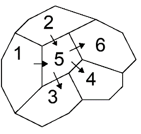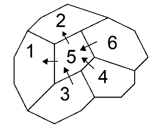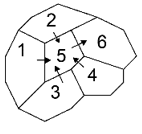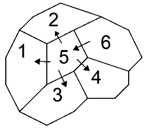This set of Computational Fluid Dynamics Multiple Choice Questions & Answers (MCQs) focuses on “FVM – Unstructured Grids”.
1. The advantage of using unstructured grids is ___________
a) vectorization
b) flexibility
c) simple arrangement
d) less memory requirement
View Answer
Explanation: Flexibility is the greatest advantage of using unstructured grids. It offers more flexibility while meshing in terms of the element types that can be used and in terms of where the elements can be concreted.
2. Which of these statements is true for unstructured grids?
a) It is simple to model and use
b) Element connectivity is implicitly defined
c) Element connectivity does not depend upon indices
d) Bounding faces can be easily found
View Answer
Explanation: All the entities should be named separately in an unstructured grid. There is no way to directly link the various entities of an unstructured grid. Thus, local connectivity has to be defined explicitly.
3. What is the cost of flexibility in unstructured grids?
a) Consistency
b) Stability
c) Accuracy
d) Complexity
View Answer
Explanation: All these properties such as consistency, stability and accuracy depends upon the method used for discretization. They do not depend on whether the grid is structured or unstructured. The cost of increased flexibility in unstructured grids is its complexity.
4. Which of these entities need the information to be explicitly stored?
a) Elements, faces, nodes and neighbours
b) Elements, faces and nodes
c) Elements, faces and neighbours
d) Elements, nodes and neighbours
View Answer
Explanation: The data structure for an unstructured grid should contain information about the elements, faces, nodes and in addition to these about the neighbouring elements also. As they are not properly arranged, the neighbouring elements cannot be defined using indices.
5. The direction of the normal to a face in an unstructured mesh depends upon __________
a) Local indices
b) Global indices
c) Direction of flow
d) Direction of increasing indices
View Answer
Explanation: The direction of the normal to a face depends on the indices in both structured and unstructured grids. For structured grids, it depends on the direction of increasing indices. For unstructured grids, the direction depends on the global index number.
6. Which of these is correct for the direction of the normal vectors to faces?
a) 
b) 
c) 
d) 
View Answer
Explanation: The normal vectors to faces in an unstructured mesh depends upon the global indices. The vector always points in the direction of increasing global indices. For element 5, a normal vector connecting the elements 5 and 6 will point towards 6. All other vectors will point towards 5.
7. Which of these formulae is correct to find the gradient of the element ‘k’?
a) ∇Φk = \(\frac{1}{V_k}(\Sigma_{n\leftarrow f<k}\Phi_n\vec{S_n}-\Sigma_{n\leftarrow f>k} \Phi_n\vec{S_n})\)
b) ∇Φk = \(\frac{1}{V_k}(-\Sigma_{n\leftarrow f}\Phi_n \vec{S_n})\)
c) ∇Φk = \(\frac{1}{V_k}(\Sigma_{n\leftarrow f}\Phi_n \vec{S_n})\)
d) ∇Φk = \(\frac{1}{V_k}(- \Sigma_{n\leftarrow f<k}\Phi_n\vec{S_n}+\Sigma_{n\leftarrow f>k} \Phi_n\vec{S_n})\)
View Answer
Explanation: The formula for the gradient, in general, is the summation of the product of the flow variables and the area of the faces. As the direction matters here, the summation will be negative till ‘n’ reaches ‘k’. Therefore,
∇Φk = \(\frac{1}{V_k}(- \Sigma_{n\leftarrow f<k}\Phi_n\vec{S_n}+\Sigma_{n\leftarrow f>k} \Phi_n\vec{S_n})\).
8. The topology of the faces in an unstructured grid depends upon ___________
a) Straddling elements
b) Boundary elements
c) Interior elements
d) Neighbouring elements
View Answer
Explanation: The information about the straddling elements is what decides the topology of the faces in an unstructured grid. Here, the flux at every element is the same. They do not vary in the direction.
9. When compared to the algorithm to calculate the gradient of a structured grid, the algorithm for unstructured grids ___________
a) need more computational cost
b) need less computational cost
c) is more accurate
d) is less accurate
View Answer
Explanation: Accuracy wise, both the grids result in the same level of accuracy as they do not involve any approximation. But, the unstructured grid algorithm needs less computational cost as it is written in terms of the global indices. This can be adopted for structured grids also.
10. Gradient for an unstructured grid is calculated by ___________
a) looping over the nodes in the computational domain
b) looping over the elements in the computational domain
c) looping over the faces in the computational domain
d) looping over the gradients in the computational domain
View Answer
Explanation: Computation of gradient for the overall domain is more efficient than calculating locally element by element. For this purpose, all the faces are looped over and the gradients are updated.
Sanfoundry Global Education & Learning Series – Computational Fluid Dynamics.
To practice all areas of Computational Fluid Dynamics, here is complete set of 1000+ Multiple Choice Questions and Answers.
If you find a mistake in question / option / answer, kindly take a screenshot and email to [email protected]
- Check Mechanical Engineering Books
- Practice Mechanical Engineering MCQs
- Check Computational Fluid Dynamics Books
- Apply for Mechanical Engineering Internship
- Practice Chemical Engineering MCQs
